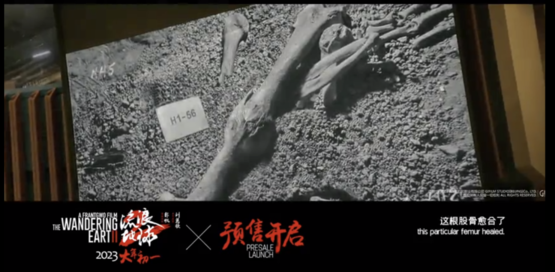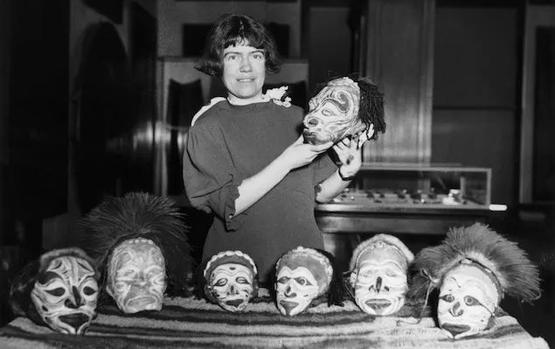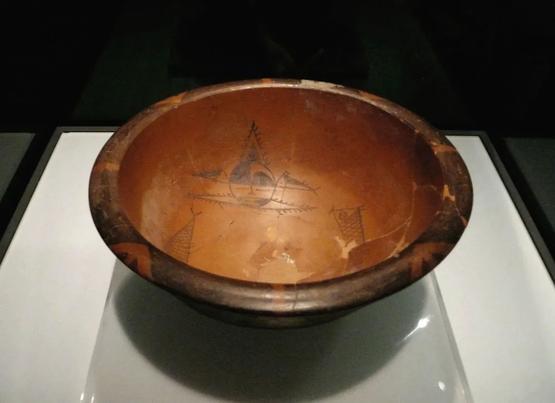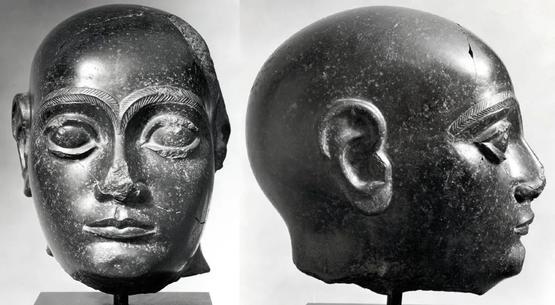In “The Wandering Earth 2”, in the face of the crisis of the moon hitting the earth, the representatives of the coalition government have been unable to reach a consensus.
At a critical juncture, the Chinese representative released a photo of a 15,000-year-old human femur: there is a kink-like protrusion in the middle of the long bone, marking that this bone was broken and healed during his lifetime. This means that incapacitated injured people have been accepted by their peers and sheltered for months until they recover. This spirit of mutual care and solidarity is what distinguishes human society from animals .

A broken and healed femur, also known as a femur|”The Wandering Earth 2″ Trailer
After the statement that “the original sign of human civilization is the healed femur “, the representatives of various countries finally let go of their suspicions and agreed on the “month”.
Margaret Mead: the patriarch of anthropology
“The original sign of human civilization was the healed femur”, this view is said to come from the American anthropologist Margaret Mead.
Margaret Mead, born in 1901, is a veteran scholar of cultural anthropology. She studied under Franz Boas, the originator of anthropology, and met her senior sister, Ruth Benedict. Among the two, the former is known as the “Father of American Anthropology”, and the latter wrote the famous “Chrysanthemum and the Sword”.

Mead was working on something called a Tzantza. Tzantza is a dried head, a custom of the aborigines in the Amazon Basin in South America. They use the heads cut off in duels or wars as trophies for a series of special treatments to preserve|theschooloflife.com
Anthropologists from the 19th to the beginning of the 20th century all had the temperament of explorers . In 1925, Meade, who graduated with a master’s degree, traveled across the ocean and came to the Samoa Islands in the South Pacific Ocean. He began a field investigation for more than half a year, eating and living with local girls. Her research during this period was later compiled into her most influential work – “A Samoan Coming of Age”.
In this book, published in 1928, Mead reflects on the differences between Western adolescents and Samoan adolescents, arguing that the restlessness of adolescence is a product of a specific culture, and that culture can shape people to a certain extent .
This conclusion may seem ordinary, but the early 20th century was the era when biological determinism prevailed. Innate genes determine life, or acquired environment shapes people? Is it the dragon that begets the dragon, the phoenix begets the phoenix, or is it that the one who is close to the vermilion is red, and is influenced by what he sees and hears? Mead and her teacher Boas took the latter side, espousing cultural determinism.
At the beginning of the 20th century, racism and eugenics based on racism were prevalent in Western society. Mead’s research on young men and women in Samoa became a thunderbolt. This is the first work in anthropology to explore the relationship between culture and personality . Since then, Mead has traveled to South Pacific islands many times, proving that cultural traditions have a huge impact on child rearing and character building.
In difficult times, heart-warming stories of “healing the thighbone” are needed
Despite Mead’s reputation in academic circles, the statement that “civilization is a healing femur” comes not from one of her books but from a memoir written by someone else.
In 1980, American physician Paul Brand recalled a lecture given by Meade in his book Terrible and Wonderful Creations. In the lecture, Mead asked “What is the first sign of civilization”?
Not clay pots, not iron, not tools or agriculture, she said, the real earliest civilization was a healed thigh bone. Mead held up the bone across the room, explaining that such traces of healing would never appear in the remnants of a competitive barbaric society.
A hominid with a broken femur was unable to walk or gather food, and the bone required months of rest to heal . A healed femur meant he wasn’t abandoned by his peers . Someone helped him, took care of him, brought him food, and took him away from danger. If there is no social culture of caring and mutual help, this person can only go to death.

In the trailer of “The Wandering Earth 2”, the representatives of China united the representatives of other countries with their thigh bones|The trailer of “The Wandering Earth 2”
However, Brand did not mention when or where Mead gave the lecture, nor did he say which site or age the bone came from. Mead himself was unable to add further explanation, since Mead died two years before the book was published.
The story of Meade and Femur was widely circulated later, and two nodes contributed to it.
Once in 2012, the story has changed a bit this time. American doctor and hospice advocate Ira Byock (Ira Byock) quoted Mead’s words in her new book “The Best Care” published that year, this time comparing human civilization with the animal kingdom, “No animal can survive After a broken leg, live till the bone heals… Helping others through is the beginning of civilization.”
The second large-scale spread was during the pandemic of the new crown epidemic . The content was similar to the 2012 version of the story, but there was an extra detail that the bones came from an archaeological site 15,000 years ago. On March 21, 2020, the Forbes website published an article titled “How a 15,000-year-old human bone can help you survive the COVID-19 crisis”. The author of the article is an entrepreneur training coach living in the UK. He talked about some heartwarming things about mutual assistance during the epidemic, and mentioned Meade and femur at the beginning. However, the author, like Biok, did not specify the source of the story.
Interestingly, the background in which this bone appears is somewhat similar to the debate crisis in “The Wandering Earth 2”. Whether or not Mead actually said it in the lecture, its circulation fits with people’s desire for mutual help in difficult times, inspires unity and gives people comfort .
What is the mark of civilization besides the thigh bone?
In Mead’s explanation of healing the femur, she sees civilization as the antithesis of “barbarism.” In addition to the ethical dimension, archeology and history believe that human society that has developed certain hardware can be called “civilization”, while earlier human creations are usually called “archaeological culture”, such as Longshan culture and Yangshao culture.

Pottery basin with human face pattern unearthed from Banpo site|Chez Cåsver
Mead also has his own views on this angle.
In an interview, Meade was asked, when does culture become civilization? “It’s a matter of definition,” she says. “Looking back, when there were great cities, an elaborate division of labor, some form of record-keeping, we would say that society is civilized. Civilization … is the technology of a particular social system. description that makes possible a particular culture.”
Cities, division of labor, and records are Mead’s definition of civilization this time. In addition, agriculture, currency, architecture, large-scale infrastructure, developed handicraft technology, etc. may also be the characteristics of a society entering civilization. Different regions have different environments, and the context and characteristics of cultural development are different. It is difficult to use one definition to describe all civilizations.
Among these conditions, words and cities are at the core .
Why are these two things so important? Because writing is the carrier of information, history and ideas, it is difficult for ideas to accumulate and spread in a society without writing; cities mean that some people can survive without agricultural production, reflecting the increase in productivity, population prosperity, and the possibility of organized division of labor.
Chinese archaeologist Xia Nai believes that bronze ware should be one of the criteria for the origin of civilization. Bronze ware can not only illustrate the superb smelting technology and the organizational ability of concentrating forces to do big things, but as a ritual vessel representing power, it has similar connotations to large ceremonial buildings, which means that there was a strong and unified ideology at that time, uniting people together.
In terms of these standards, the Sumerians in Mesopotamia took the lead in crossing the threshold of civilization in 3500 BC. They founded city-states, built temples, and carved cuneiform characters on clay tablets with reed sticks. Created a prosperous Sumerian civilization.

Headshot of Sumerian ruler Gudea Wikimedia Commons
The thighbone photo in “The Wandering Earth” was taken 15,000 years ago, when humans were still at the end of the Paleolithic Age and had not yet entered settled agriculture from hunting and gathering. There may be human “civilization” among individuals in the tribe , but the overall society has not yet reached “Civilization” stage.
As Meade said in the interview, civilization is the description of a particular social system. The sacrificial pit full of healed femur bones and corpses may be a symbol of civilization from a certain angle.
We don’t know how civilization will develop in the future. If it really comes to the point of life and death, it may be like what the protagonist said at the end of the movie: ” The fate of civilization depends on the choices of human beings. “
references
[1]Did Margaret Mead say that a healed femur is the earliest sign of civilization?
https://ift.tt/AnCIj6m
[2]Did Margaret Mead Think a Healed Femur Was the Earliest Sign of Civilization?
https://ift.tt/z9h5B6H
[3]How A 15,000-Year-Old Human Bone Could Help You Through The Coronacrisis
https://ift.tt/uMVBC43
[4] TALKS WITH SOCIAL SCIENTISTS: Margaret Mead on what is a culture? what is a civilization?
https://ift.tt/Vzu1iMK (Originally published in Talks with Social Scientists. Edited by Charles F.
Madden. Southern Illinois University Press, 1968)
[5] Zhang Fan, “The Combination of Anthropology and Social Psychology: A Review of Margaret Mead’s Cultural Determinism”, “Social Science Review”, 2007, (03)
Author: vicko238
Editor: Xiaotowel, You Shiyou
Cover image source: “The Wandering Earth 2” trailer
This article comes from Guoke, and shall not be reproduced without authorization.
If necessary, please contact [email protected]

This article is transferred from: http://www.guokr.com/article/463361/
This site is only for collection, and the copyright belongs to the original author.
